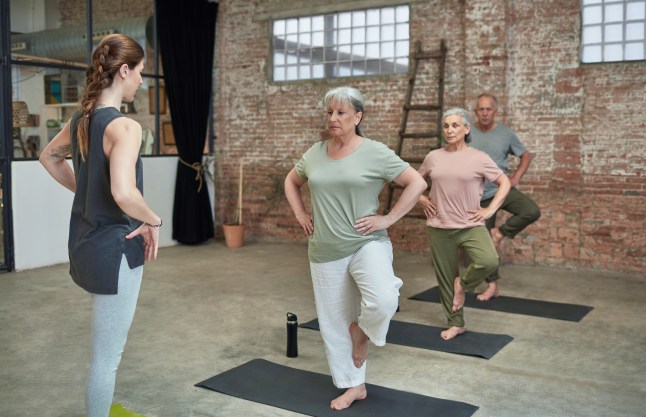18 Sep, 2025 | Admin | No Comments
How long you should be able to stand on one leg, according to your age


Unless you’re a budding yogi, it’s not often that you stand on one leg. After all, you’re not a flamingo.
But this quick minute(ish) activity can actually reveal a lot about your physical health.
It’s no secret that our bodies change as we get older: from wrinkles to our hair, to memory recall and the ability to digest certain foods.
But research has revealed that standing on one leg can be a strong indicator of how well you’re ageing.
In a study published in the journal of PLoS One in 2023, researchers found that strength and balance involved in the pose is among the first to go.
They discovered a sharp drop off in ability after the age of 65, with many older participants struggling to hold the pose for more than two seconds.
The authors wrote: ‘These findings suggest that the duration of unipedal stance [standing on one leg] can serve as a reliable and gender-independent measure of neuromuscular ageing for both elderly male and female subjects.’

So, standing on one leg is a good way to measure how much balance you have. The researchers wrote that it is a ‘a valid measure of frailty, independence, and fall status and proves to be a useful tool in identifying patients with peripheral neuropathy.’
And it’s not just academic – the NHS has a guideline for how long you should be able to stand on one leg for – depending on your age of course.
Back in 2023, the NHS Suffolk and North East Essex Integrated Board asked: ‘How long can you stand on one leg like a flamingo?’
They added: ‘It might sound like an odd question, but your answer to the above question could tell you a lot about your general health and fitness’.

The rules are:
- Stand on one leg without any other support
- Keep your eyes open and your hands on your hips
- Time starts when your foot leaves the ground and stops when you put your foot back down (or when you take your hands off your hips)
Ages 18-39: 43 seconds

If you are aged between 18-39, you should be able to stand on one leg, like a flamingo, for 43 seconds.
Selina Lim, Divisional Director for Integrated Pathways at the NHS East Suffolk and North Essex NHS Foundation Trust (ESNEFT), said: ‘We know that people who struggle to balance for the expected amount of time are at a higher risk of developing ill-health as they age.
‘By taking part in the “flamingo challenge” people can quickly and easily assess for themselves whether they are at risk. If they are, there are lots of different activities they can engage in that can help improve their overall fitness.’
Ages 40-49: 40 seconds

If you are aged between 40 and 49, you should be able to stand on one leg for 40 seconds.
Doesn’t sound like a long time, but as you get older, the length of time you can stand on one leg decreases
Ages 50-59: 37 seconds
Those aged between 50 to 59, you should be able to stand on one leg for 37 seconds.
According to the British Journal of Sports Medicine, the inability to stand on one leg for 10 seconds in mid to later life is linked to a near doubling in the risk of death from any cause within the next 10 years.
Ages 60-69: 30 seconds

If you are aged between 60 to 69, you should be able to stand on one leg for 30 seconds.
Debbie Dyer, Clinical Lead for Ageing Well and Anticipatory Care at the North East Essex Alliance, said: ‘Moving our bodies more day-to-day brings immediate benefit, too. Exercise is brilliant for mental health and is a great way of meeting new people in your community.
‘The fitter and healthier you are, the better your mental wellbeing, and the longer you will retain your agility, strength, and balance into later life.’
Ages 70-79: 18 seconds. 80+: 5 seconds

Those aged between 70 to 79 should be able to stand on one leg for around 18-19 seconds. If you’re over 80, you should be able to stand on your leg for a little over 5 seconds.
The NHS recommends not to try and maintain the pose for longer than a minute though.
This article was originally published November 28, 2024.
Do you have a story to share?
Get in touch by emailing MetroLifestyleTeam@Metro.co.uk.
18 Sep, 2025 | Admin | No Comments
Melania Trump’s skirt suit oozes elegance: here’s where you can get the look for less

Metro journalists select and curate the products that feature on our site. If you make a purchase via links on this page we will earn commission – learn more
The pomp and pageantry were on full display this afternoon as President Donald Trump and First Lady Melania Trump arrived at Windsor Castle.
Greeted by King Charles, Queen Camilla, and the Prince and Princess of Wales, it marked day one of the official state visit.
The Grenadier Guards’ procession was nothing short of impressive but, let’s be honest, all eyes were on Melania and what she’d chosen to wear for the grand occasion.
FLOTUS stepped out in an understated black skirt suit, paired with classic black pumps, topped off with a wide-brimmed purple hat – possibly to keep the Great British weather from ruining her hair and makeup, but we couldn’t possibly speculate.
While we haven’t had confirmation on the exact designer just yet, we’re pretty confident it didn’t come cheap.
The First Lady is no stranger to luxury fashion, frequently stepping out in labels like Burberry, Dolce & Gabbana, and Dior.
And while the high-end designs are beautiful, there’s really no need to splash the cash as the high street has fantastic alternatives that capture the same timeless elegance without breaking the bank.
With brands like Aligne, River Island and Sainsbury’s Tu bringing forward their own, far more affordable alternatives to the sleek two-piece outfit, getting that power suit look has never been easier.
So if you’re looking to recreate Melania’s look, we’ve rounded up some of the best versions from the high street that are sure to tick your boxes.
Best high street skirt suits:

Aligne Bonnie Ponte Waisted Blazer
Nail power dressing with the Aligne Bonnie Ponte Waisted Blazer, a ponte curved sleeve blazer designed with a fitted silhouette and waist split for a flattering shape. It has an exposed placket with functional buttons down to the waist making it practical, comfy and chic.

Sainsbury’s Tu Clothing Black Tailored Midaxi Skirt
With a split hem at the front, this tailored midaxi skirt from Tu Clothing has a structured shape and a chic length that falls between midi and maxi. Made from stretch fabric, it’s comfortable but smart enough for workwear or smart-casual occasions.

River Island Black Collarless Blazer
This collarless blazer from River Island has a clean, minimalist and modern design with a tailored fit and buttoned fastening. It includes side slip pockets, long sleeves, and is made from a midweight fabric. Pair it with a black pencil skirt like Melania or a great pair of denim jeans for a more casual look.

Next Black Tailored Pencil Skirt With Wool
This Next pencil skirt has chic tailored detailing and finishes at the knee. Added wool gives warmth and structure, and the split at the black makes it comfortable for moving around. It comes with a matching Black Tailored Single Breasted Blazer With Wool (£55) to wear together or as separates.
Taking cues from Melania Trump’s elegant state visit ensemble, it’s clear that an understated black skirt suit will never go out of fashion.
Follow Metro across our social channels, on Facebook, Twitter and Instagram
Share your views in the comments below
18 Sep, 2025 | Admin | No Comments
M&S has created the versatile designer-looking LBD for every winter occasion

Metro journalists select and curate the products that feature on our site. If you make a purchase via links on this page we will earn commission – learn more
Marks and Spencer is back in action after the cyber attack, and we couldn’t be happier as we can finally shop the hero fashion pieces from the high street label once again – and with the Click and Collect option too.
M&S regularly drop new launches, and while many are shopping for Marks & Spencer’s seasonal jackets, I have my eyes on the Scoop Neck Mini Waisted Dress, which looks far more premium than its high street price tag.
In fact, we’d go as far as to say the M&S design is a close ringer for Saint Laurent’s Décolleté Knit Mini Dress, which fetches £2,890. Though we prefer the structure of the M&S design more.

Scoop Neck Mini Waisted Dress
Crafted from a mixed blend of polyester, viscose and wool, this dress offers insulation and structure. It boasts a scoop neck, ¾ length balloon sleeves, as well as a structured bodice that fits at the bust and waist but flares out into an A-line skirt. Available in UK dress sizes 6 to 20.
M&S’ Scoop Neck Mini Waisted Dress has been crafted from a blend of polyester, viscose and wool, which suits the colder autumn/winter seasons better. Not only does the material lend itself for extra insulation, but it also achieves a structured finish that holds its shape, hence why it’s ideal for more formal dos or when you want to look polished.
This design oozes elegance as it features a three-quarter length balloon sleeve, a scoop neckline and a structured bodice, which creates a fitted bust, cinched in waist but offers a flared silhouette around the skirting to add volume.
The attention to detail proves that this tailored design has been crafted with women in mind as it flatters the wearer in all the right places. The flared mini skirt is simply genius, as it gives the illusion of a slimmer waist, it also conceals the stomach that many women are conscious of (us included), and it also gives the illusion of tall and slender legs too.
It features a zip fastening, which makes it easy to slip into, and out of, after a long day.
The dress is available in black, and ranges from UK dress sizes 6 to 20.
While we would pair with heels and glitzy accessories to attend an autumn/winter wedding reception, we would also slip on a pair of tights, even diamante versions, for the Christmas party season or New Year celebrations – yes, we are thinking that far ahead.
Having said that, this dress is also perfectly paired with court shoes for the office, or an afternoon tea with pals. Though you could slip into ballet pumps for a day spent shopping.
The dress is part of M&S’ Autograph collection, and fetches £100. Yes, it may be a higher sum than some dresses we have purchased from M&S, but it’s so worth it considering the quality. Plus, we can justify the price tag when we remember the £2,790 we’d be saving.
Follow Metro across our social channels, on Facebook, Twitter and Instagram
Share your views in the comments below
17 Sep, 2025 | Admin | No Comments
The Princess of Wales sparkles in one-of-a-kind tiara after innovative transformation

Kate Middleton, the Princess of Wales, attended the state banquet with Donald Trump for the president’s UK state visit, and Prince William’s wife wowed in a stunning tiara.
17 Sep, 2025 | Admin | No Comments
7 pests you'll see more of in autumn – and how to get rid of them

These unwelcome visitors are looking to get cosy in your autumnal home as temperatures begin to drop – here’s how to keep them at bay
Cat Deeley wore French Connection’s Brandy Snakeskin skirt to host This Morning on Wednesday and it’s the perfect piece for autumn 2025 if you’re not a fan of leopard. Shop the look for £89.
17 Sep, 2025 | Admin | No Comments
Shoppers say this ‘divine’ £12 fragrance from M&S is a dead ringer for a £170 version

Metro journalists select and curate the products that feature on our site. If you make a purchase via links on this page we will earn commission – learn more
Beauty dupes used to have a bit of a bad reputation. They were often cheap knock-offs that didn’t quite hit the mark, but over the years, things have changed big time.
Now, you can find budget-friendly products that are dead ringers for their high-end alternatives – at a fraction of the cost.
One of those impressive dupes is the M&S Apothecary Warmth Eau de Parfum that comes in at just £12.
It’s causing a serious buzz on TikTok and Instagram because it smells almost identical to the iconic Le Labo Santal 33, a cult fragrance that costs a whopping £170.
Don’t get us wrong, Le Labo’s fragrances are gorgeous and among some of our all-time favourites, but there’s nothing wrong with wanting to save your money.
And with that being said, Warmth might just be one of the best affordable fragrance finds on the high street right now.
With notes of cardamom, sandalwood, cedar, and cinnamon leaf, it mirrors Santal 33’s creamy, woody scent that fragrance fans can’t get enough of.
Spritzed onto pulse points, it smells warm, grounding and cosy, making it a perfect choice for the cooler days of autumn and winter when you’ve switched out your fresh florals from summer.
Part of M&S’s Apothecary collection of wellbeing scents and available as a range of home, bath and body products, it’s designed to evoke feelings of comfort and calmness – and we can attest to this. It smells cosy and reassuring, somehow.
Now, you might think that a £12 fragrance couldn’t possibly stand up to a luxury £170 one in terms of scent and longevity but, the high street store’s use of high-quality essential oils and expertly blended notes makes the two pretty much indistinguishable.
Don’t believe us? Just take a look at some of the glowing reviews from happy customers. One review from a shopper named Suzie1992 says: ‘Obsessed with this scent, the body wash is also great. Smells just like Santal 33.’
And a review from user Sunnysue28 reads: ‘Love this stuff! So warm and comforting, it just smells amazing! A colleague wore it at work and she smelled fabulous so I couldn’t resist treating myself. Use it day to day as it’s such a great price. Go on and spoil yourself, you’ll not regret it!’
And a review left by a shopper called Kew1010 says: ‘A wonderfully warm scent for winter time. Musky and woody but so natural. No nasty chemical or manufactured smell here, a must for the over 40’s woman looking for something special and different without the usual designer price tag. Well done M&S.’
If you love warm, woody scents and you’re looking to try something new or you’re a Santal 33 superfan but want to save some cash, at £12, this fragrance really is a no-brainer.
Follow Metro across our social channels, on Facebook, Twitter and Instagram
Share your views in the comments below
Will Smith and Jada Pinkett Smith’s son Jaden Smith was named the men’s creative director of Christian Louboutin — and his fans are more than a bit divided…
17 Sep, 2025 | Admin | No Comments
Cult UK brand announces closure and launches huge ‘everything must go’ sale


After more than 25 years in business, UK footwear brand Irregular Choice is closing down.
Since its inception in 1999, the company has built up a cult following for its quirky embellished heels, colourful fabrics and eye-catching designs.
At the peak of its popularity, Irregular Choice sold to over 50 countries worldwide, with a flagship store on London’s Carnaby street alongside locations from Manhattan to Hong Kong.
As of September 28 however, the firm’s last remaining shop in Brighton will shut and its website ‘will be deactivated indefinitely shortly afterwards’,
In a social media announcement, founder Dan Sullivan explained: ‘We have faced significant challenges in recent years, from pandemic struggles, rising costs, economic uncertainty, and last year, the liquidation of our main distributor who owed us and our factory a huge amount of money.
‘All of these variables created a perfect storm of difficulties, and despite quietly fighting hard behind the scenes, we now face the closure of our beloved factor partner of 25 years – a small family business and dear friends. Without them, Irregular Choice must take a step back and re-evaluate what the future may hold.’
Fans were devastated at the news, with the Facebook post garnering over 3,000 comments.
‘I can’t believe what I’m reading, I’m utterly shocked and distraught at the same time!’ said Claire Jane Law, who has collected over 70 pairs of Irregular Choice shoes since 2005. ‘Today is a dark day and I never thought in a million years this would happen.’

‘Absolutely gutted! Each and everyone of your shoes is a piece of art!’ wrote another, Natalie Norman, while Jodi Baker added: ‘Another blow for the industry. Keeping everything crossed it won’t be goodbye forever from such a creative and inspiring brand that pushed against the norms. Thank you for making me smile with every design.’
Others shared pictures and stories of their favourite Irregular Choice pieces, from bow-adorned wedding heels to My Little Pony boots that are always ‘noticed and commented on.’
A ‘big clear out sale’ has since been launched to sell remaining stock, with every item on the company’s website discounted by between 20% and 70%.
Many products have already sold out, but some cut-price footwear is still available, including sliders reduced from £109 to £45, heels reduced from £105 to £63, and brogues reduced from £115 to £69.
Customers can also still get their hands on printed tights (featuring Tweety Bird, no less) for under £20 and handbags – which usually retail for upwards of £149 – priced at £99 or less.
Irregular Choice is the latest in a string of UK businesses to collapse in recent years – and fashion retailers seem to be among those hardest hit.
Claire’s, Select and Quiz have all gone into administration in 2025, while River Island is undergoing a major restructuring plan of store closures and substantial job cuts in an effort to avoid insolvency.
Some have bucked trends though; most notably Topshop, which is making a dramatic return to the high street after four years away. The comeback hasn’t quite stretched to a standalone store, but its clothes are now stocked in Liberty, and its upcoming spring 2026 collection will be available at John Lewis shops throughout the country.
And in an economic landscape where we’re losing beloved brands every day, every win counts.
Do you have a story to share?
Get in touch by emailing MetroLifestyleTeam@Metro.co.uk.
17 Sep, 2025 | Admin | No Comments
5 ways to dry your clothes without a tumble dryer – even when it rains

Get inspired this autumn/winter as we explain ways to dry your clothes when it is raining outside and you don’t want to put the tumble dryer on.







